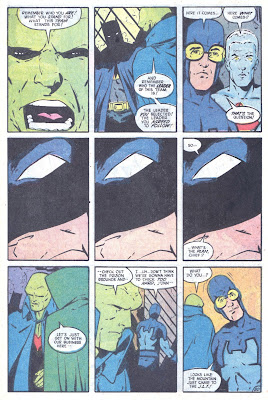80th Anniversary Edition
by Robert Kanigher
Famous Comics, 2023
ISBN - 978-1945307362
Robert Kanigher (1915-2002) was one of the most prolific writers of American mainstream comics, well known as the creator of characters like Sgt. Rock, The Metal Men, The Haunted Tank, Enemy Ace, King Faraday, The Flash (Barry Allen) and more.
In 1943, a few years into the business and having written for Fox, MLJ, Fawcett and others, he wrote a series of books on writing for Cambridge House. HOW TO MAKE MONEY WRITING FOR COMICS MAGAZINES was one of them [*] (his original title was apparently BREAKTHROUGH before the publisher changed it). The "Comics Magazine" version was recently reprinted in a print-on-demand book from the Famous Comics division of SD Publishing (branching out from their vast and growing Ditko catalog), with a lot of enhancements to the original and additional features.
[*] The others were HTMMW FOR THE MOVIES, HTMMW FOR THE STAGE, HTMMW FOR RADIO, HTMMW FOR NEWSPAPERS AND MAGAZINES and HTMMW POPULAR BOOKS. Some of them were compiled into a hardcover HOW TO MAKE MONEY WRITING
As you can see, the new book is significantly bigger than the original. It's also more than twice as many pages. The first half of the book, following some new introductory material from editor Robin Snyder, is the full contents of the 1943 book.
In addition, a Captain Marvel script from Fawcett is included as in the original, but now accompanied by the actual comics story from the Beck Studios, so you can make a script-to-page comparison.
The original also has a Steel Sterling story drawn by Irv Novick from MLJ, along with a panel-by-panel running commentary by Kanigher. The original presents the story in black and white, the new version in full colour.
It's an endlessly fascinating book. Kanigher writes it in a comfortably conversational spontaneous style (apparently he wrote all six books in six weeks for $500), but imparts a lot of information on his process. You have to keep in mind that he's specifically talking about writing adventure comics featuring pre-existing characters for kids of the 1940s, so a lot of the specific advice is aimed squarely at that (and can be a bit dated 80 years on), but there's also a lot of general information that still applies on how to see the panel and page as distinct units that you need to think of in different ways from radio or film scripts, and how communicate information to the artist or sell the story to the editor.
But that's only the first half of the book, less than 100 pages of the 226 pages, even with the extra comic story included. The rest of the book is a great general overview of the first decade of Kanigher's career in comics, including three more complete stories (Samson, Blue Beetle and The Bouncer), samples from some of his DC work (Wonder Woman, Green Lantern, Flash), including some rarities like unpublished script samples from planned later day returns to those characters. Those are accompanied by introductory text by Robin Snyder and two long 1990s essays by Kanigher, "The Flushing Of Flash" (a look at his history with the Flash) and "So Long, Scribbly" (an epic obituary for Sheldon Mayer, and maybe the highlight of the book for me if I hadn't already read it).
And to top it all off, the first part of "The Mystery Of The Human Thunderbolt", an as-complete-as-possible year-by-year bibliography of Kanigher's writing and editorial work. Covering just his first decade in comics from 1941 to 1950 takes 34 pages. Of course that barely scratches the surface, with his most prolific period as the editor and main writer of DC's war comics line and much more still ahead (previewed by a Sgt. Rock script rarity in the end of the book).
Great looking book, and much cheaper and easier to get than the original. As noted, it's print-on-demand, so readily available from various retailers on-line and (I think you can still do this) in person. You shouldn't have to pay much more than US$35 and minimal postage (you can currently get one in Canada for under US$30 with all shipping and taxes. Some places mark-up print-on-demand books to a crazy degree). Use the International Standard Book Number 978-1945307362. Options include:
Chapters/Indigo
Barnes&Noble
Amazon.com (adjust to your localized Amazon outside the US)
Bookfinder
AbeBooks





















